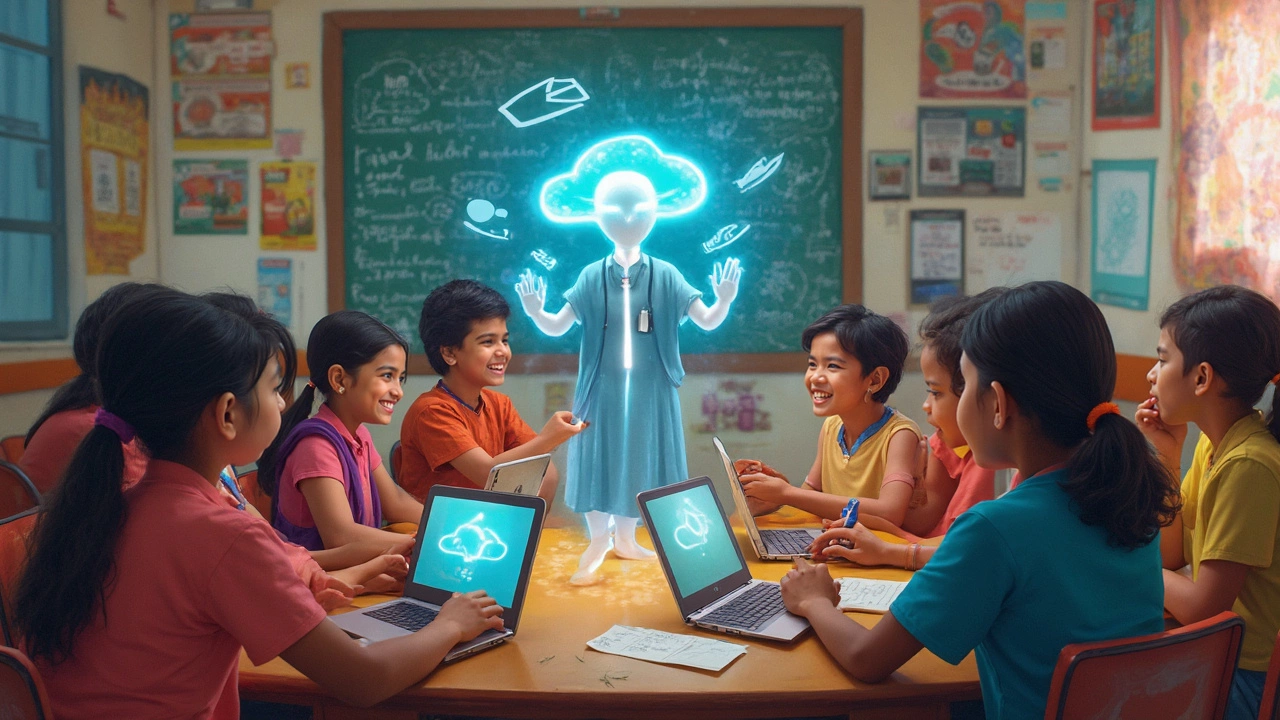
You'd think that learning from the comfort of your couch while wearing your favorite pair of pajamas sounds ideal, right? Well, it turns out, eLearning isn't all sunshine and rainbows. It's got its own set of issues that can make or break the learning experience.
Let's start with one of the biggest problems—staying engaged. It's pretty easy to lose focus when Netflix is just a click away, or when online classes start feeling like digital lectures without the personal touch of a classroom. Teachers often struggle to keep that spark alive through a screen.
Then there's the matter of interactivity. Sure, you have quizzes and forums, but they don't always replace real-time discussions and debates that come naturally in face-to-face settings. That lack of interaction can leave students feeling isolated and disconnected.
- The Engagement Dilemma
- Interactivity or Lack Thereof
- Tech Troubles
- Accessibility Barriers
- Content Overload
- Making the Most of eLearning
The Engagement Dilemma
Engagement in eLearning is like a slippery fish—hard to catch and even harder to hold onto. The shift to online education has been massive, but getting students to focus when there’s a sea of distractions is a tough nut to crack. In traditional classrooms, teachers can rely on eye contact, body language, and immediate feedback to keep students hooked. Take that away, and you've got a bunch of learners zoning out.
What's more, the binge-worthy temptation of various streaming entertainment can easily distract from a humdrum virtual lecture. To top it off, the asynchronous nature of digital learning often means that students can just skip live sessions and try to catch up later, losing the immediacy and the buzz of live interaction.
Many educators have turned to tech tools to spice things up. Interactive platforms like Kahoot or Padlet inject a bit of fun into the mix. But over-relying on them can lead to 'tool fatigue,' where students tune out because everything feels gimmicky.
Keeping students engaged isn't rocket science, but it does require a thoughtful approach. Here’s some ammo for making e-learning work:
- Break it up: Try shorter bursts of content. Why not swap a 60-minute lecture for a few 10-minute interactive segments?
- Mix it up: Use a variety of media like videos, quizzes, and group work so students don't fall asleep on you.
- Make it relevant: Show how lessons apply to real-world scenarios. When students see a direct link to their lives, they’ll likely pay more attention.
A stat from a 2023 study on digital classroom engagement highlighted that courses using varied teaching methods engaged 25% more learners than traditional online lectures. Productive engagement requires active involvement, so the more a course can pull a student into the learning process, the better.
Interactivity or Lack Thereof
Remember those group projects at school where you got to brainstorm with your buddies? Online education sometimes misses that boat. The hustle and bustle of a real classroom often don't translate well to digital learning. Sure, there are forums and discussion boards, but let's be real—they rarely catch the same vibe.
eLearning platforms come with bells and whistles like quizzes and polls to keep things lively. But they don't always succeed. According to Education Week, only about 47% of students felt engaged or interactive during online classes. It's like trying to have a juicy conversation through a tin can telephone—often more static than substance.
"True interaction comes from a two-way street of learning, where students feel heard and can engage actively." - Jane Smith, Professor of Educational Technology.
Here's the kicker—interactivity isn't just about having cool tech. It's about how we use that tech effectively. Some schools have found success with virtual group projects or allowing students to co-create content. They mix things up with online education tools that encourage active participation, like live quizzes where speed matters or collaborative documents everyone can edit in real-time.
Want a quick idea to boost interactivity in your online course? Consider using video calls for live feedback sessions instead of pre-recorded lectures. It's a small tweak but can make a world of difference in making students feel more connected.
Interactivity can be tricky in the online world. As teachers and learners, it's about finding the right tools and methods to pull everyone into the conversation. No one wants to stare at a lonely screen.
Tech Troubles
Alright, let's talk about the elephant in the virtual room—tech troubles. Anyone who's tried their hand at eLearning knows that tech hiccups are part and parcel of the experience. From crashing apps to connectivity woes, these issues can disrupt even the most dedicated students.
One of the most common struggles is the infamous internet connection problem. Imagine you're on the brink of understanding something crucial, and boom! Your Wi-Fi goes down. To make online education smooth, a reliable internet connection is a must.
Then there are software glitches. Platforms often struggle with bugs, user interface challenges, and compatibility issues. Not every device plays nice with every learning app, which can drive you up the wall if you’re trying to access a course from your phone or an older laptop.
Security and privacy are another big deal. With all this data flying around, both students and educators need to ensure their personal information stays safe. It's not just about learning; it's about learning safely.
Ever tried to troubleshoot your way out of a tech jam? It’s not everyone's cup of tea, especially when stress levels are already high during exams or crucial assignments. Institutions offering online education could really benefit from having tech support that's both available and approachable.
To wrap it up, if educational platforms don't address these digital learning challenges, they risk leaving students lagging, which isn’t great when you're gunning for success.

Accessibility Barriers
We often hear that online education is the future, but not everyone gets an equal ticket to ride. Accessibility is a huge problem in eLearning, and it's one that really needs some serious attention.
The first roadblock? Internet access. Sounds a bit odd in this day and age, but yep, not everyone has reliable or fast internet at home. For some folks, Wi-Fi is as mythical as unicorns. This digital divide can make it nearly impossible for students to attend virtual classes or access learning materials, especially if video streaming and frequent downloads are required.
Then there's the issue of devices. Say you've got four kids and one computer. How do all of them get their learning done? They can't. Many families face the tough choice of who gets the screen time, and sometimes, there just aren't enough devices to go around.
Let's not forget about students with disabilities. Sure, digital learning can be a godsend for some, but badly designed interfaces can turn learning into a nightmare for others. Students who rely on screen readers or need text alternatives often find themselves struggling if the platform isn't built with accessibility in mind.
Language can also be a barrier. If materials aren't available in multiple languages, or if translations aren't up to scratch, students who don't speak the dominant language might find themselves in a bind.
So, what's the fix? Well, schools and eLearning platforms can start by making sure their resources are universally designed. That means considering all sorts of needs from the get-go. They could offer lower-bandwidth options for videos, ensure materials work for assistive technologies, and provide content in various formats and languages.
Even small steps can mean the difference between learning and being left behind.
Content Overload
So here's the thing with online education: more is not always better. In fact, having too much information can actually be a real headache. We're talking about eLearning platforms here—some are packed to the brim with content, and it can be overwhelming.
Imagine you're trying to drink water, but instead of a nice, steady stream, you get hit with a fire hose. That's how it feels sometimes when you're bombarded with endless videos, PDFs, and slide decks. It’s easy to see how students might feel buried under all that information.
The root cause? A lot of online courses are designed to dump as much content as possible, thinking that quantity equals quality. But guess what? Too much material can be just as bad as too little. It can cause learners to skim through topics without really grasping them or encourage procrastination—because who wouldn't be daunted by pages and pages of notes?
Let’s break down some tips on how to tackle this:
- Prioritize: Focus on what's key. If your course has a ton of resources, start with the most relevant ones.
- Chunk it: Break down your study sessions. Instead of racing through everything, tackle one bite-sized section at a time.
- Plan: Create a schedule that allocates time for each module. Stick to it to avoid last-minute cramming.
- Engage: Try to interact with the material. Join discussions, take part in quizzes, or apply what you've learned in real-life scenarios.
And remember, more content doesn't always mean more learning. Quality trumps quantity every time when it comes to effective learning. So, don't feel bad about skipping a couple extra readings if they're not doing you any favors.
Making the Most of eLearning
Alright, we've figured out the hurdles of eLearning, but how do we turn it into a powerhouse for learning? Let's break down some effective strategies that can make online education work for you.
First off, setting up a dedicated study space at home can work wonders. It's your personal classroom that can help kick distractions to the curb. Keep it organized and ensure it's equipped with everything you need, just like an actual classroom desk.
Next, take control of your time. Online learning requires a bit more self-discipline. Set a regular schedule and stick to it. It's not just about logging in; it's about actively engaging with the material. Use tools like digital planners or apps to keep track of assignments and deadlines.
The power of community shouldn't be underestimated, even online. Engage in discussion boards, join study groups, and don't hesitate to reach out to instructors with questions. Building connections with peers can provide both support and motivation.
Maximize your resources. Most online education platforms offer a range of materials, from video lectures to e-books. Mix and match different formats to see what works best for you. Digital learning is flexible, so find a rhythm that keeps you engaged.
If you're struggling with complex topics, look for supplementary resources. Educational websites, YouTube tutorials, and even podcasts can provide different angles on the same subject, making it easier to grasp difficult concepts.
Lastly, take breaks and reward yourself. Online education can be intense, so pacing yourself with short breaks can keep your mind fresh. After a productive study session, give yourself a pat on the back or treat. It's important to keep the experience positive.
So, roll up your sleeves and get the most out of digital learning. With a mix of discipline, interaction, and resourcefulness, eLearning can become a valuable tool in your education journey.




